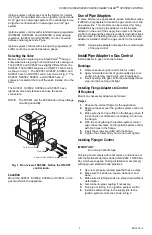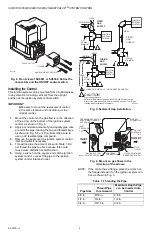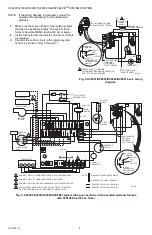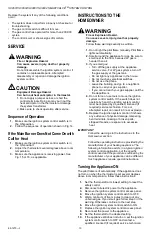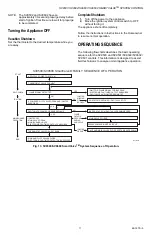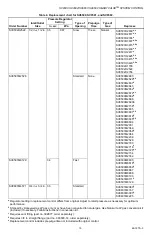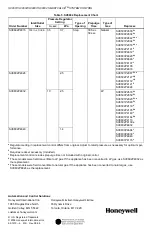
SV9501/SV9502/SV9601/SV9602 SMARTVALVE
TM
SYSTEM CONTROL
69-1270—3
8
Turning on the System
Push the switch to the ON position.
Turning on the Main Burner
Follow the instructions provided by the appliance
manufacturer or turn up the thermostat to call for heat. If
the main burner does not light, refer to the troubleshooting
table.
Perform Gas Leak Test
WARNING
Fire or Explosion Hazard.
Can cause severe injury, death or property
damage.
1. Check for gas leaks with soap and water
solution every time work is done on a gas
system.
2. Stand clear of the main burner when lighting it
to prevent injury from hidden leaks that could
cause flashback.
Gas Leak Test
1.
Paint the pipe connections located upstream from
the ignition system control with a rich soap and
water solution.
Bubbles indicate a gas leak.
2.
If a leak is detected, tighten the pipe connections.
3.
Repeat steps 1 and 2 until no leaks are detected in
that area.
4.
Light the main burner.
5.
With the main burner in operation, paint the pipe
joints, adapters, and control inlet and outlet with a
rich soap and water solution.
6.
If a leak is detected, tighten the adapter screws,
joints, and pipe connections.
7.
Repeat steps 5 and 6 until no leaks are detected.
8.
Replace the part with the same model number if
any leak cannot be stopped.
Adjust the Pilot Flame
The pilot flame should envelop 3/8 in. to 1/2 in. (10 mm to
13 mm) of the tip of the flame rod, as shown in Fig. 12.
1.
Remove the pilot adjustment cover screw.
2.
Turn the inner adjustment screw clockwise to
decrease or counterclockwise to increase the pilot
flame.
3.
After adjusting the flame, replace and tighten firmly
the cover screw to prevent gas leakage.
NOTE: Controls are provided with adjustment screws
set at the maximum pilot flow position.
Fig. 12. Proper flame adjustment.
Check and Adjust Gas Input
and Burner Ignition
IMPORTANT
— Many replacement valves require outlet pressure
adjustment.
— Do not exceed the input rating stamped on the
appliance nameplate.
— Do not exceed the manufacturer’s
recommended burner orifice pressure for size of
orifice used.
— Make sure the primary air supply to the main
burner is properly adjusted for complete
combustion.
— Follow the appliance manufacturer’s
instructions.
If Checking Gas Input by Clocking Gas Meter
1.
Make sure there is no gas flow through the meter
other than the flow to be checked.
2.
Other appliances supplied by this meter must
remain off with their pilots extinguished or their gas
consumption must be deducted from the meter
reading.
3.
Convert flow rate to Btuh as described in Gas
Controls Handbook, form 70-2602, and compare
the result to the Btuh input rating on the appliance
nameplate.
If Checking Gas Input with Manometer
1.
Make sure gas supply is shut off at the manual
valve in the natural gas piping to an appliance or at
the tank for LP gas before removing the inlet
pressure plug.
2.
Make sure the ignition system control is in OFF
position when removing the gauge and replacing
the plug.
3.
Make sure the ignition system control is in OFF
position before removing the outlet pressure tap
plug and connecting the manometer (pressure
gauge).
4.
Shut off the gas supply before disconnecting the
manometer and replacing the plug.
5.
Repeat the gas leak test at the plug with the main
burner operating.
PROPER FLAME
ADJUSTMENT
HOT SURFACE
IGNITER
FLAME ROD
M3350A
GROUND
ELECTRODE
3/8 TO 1/2 IN.
(10 TO 13 MM)
NOTE: GROUND ELECTRODE MUST NOT TOUCH FLAME
ROD (.050 IN. MINIMUM CLEARANCE). BEND GROUND
ELECTRODE IF NECESSARY. DO NOT BEND FLAME ROD.



